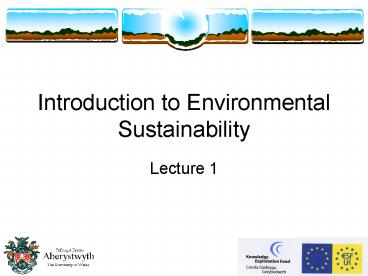Introduction to Environmental Sustainability - PowerPoint PPT Presentation
1 / 22
Title:
Introduction to Environmental Sustainability
Description:
Social and economic. Conservation and management of natural resources ... Resource conservation/environmental protection. Built development. Environmental quality ... – PowerPoint PPT presentation
Number of Views:3290
Avg rating:3.0/5.0
Title: Introduction to Environmental Sustainability
1
Introduction to Environmental Sustainability
- Lecture 1
2
Lecture summary
- Introduction
- History
- What is sustainable development?
3
Introduction
- 2050 8 billion people
- 90 of increase in developing countries
- Pressure on
- Energy
- Food
- Forests
- Natural resources
4
First world countries
- Organisation for Economic Co-operation (OECD)
- 16 of the worlds population
- Consume 11x more energy per head
- Create half the CO2 from fossil fuels
- Create 75 of the industrial waste
- Create 80 of hazardous wastes
5
(No Transcript)
6
The Brundtland reportdefined SUSTAINABLE
DEVELOPMENT AS
- development that meets the needs of the present
without compromising the ability of future
generations to meet their own needs
7
The Brundtland report
- The report was concerned with
- securing a global equity
- redistributing resources towards poorer nations
- encouraging the economic growth of poorer nations
8
The Brundtland report
- Components of sustainable development
- environmental protection
- economic growth
- social equity
9
Rio Earth Summit
- Over 30,000 participants
- Objectives
- Build on Brundtland Report
- Respond to pressing global environmental problems
- Agree major treaties
10
Rio Earth Summit
- Five agreements made
- The Convention on Biodiversity
- The Framework Convention in Climate Change
- Principles of Forest Management
- The Rio Declaration on Environment and
Development - Agenda 21
11
Agenda 21
- Established at the Earth Summit
- A commitment to sustainable development
- Agreed by many governments
12
Agenda 21
- 4 elements
- Social and economic
- Conservation and management of natural resources
- Strengthening role of major groups
- Means of implementation
13
Agenda 21
- Nations monitored by the International Commission
on Sustainable Development - Promoted at regional and local levels
- Many problems and solutions have roots at the
local level - Local authorities have pivotal role in fulfilling
the objectives
14
Local authorities
- construct, operate and maintain economic, social
and environmental infrastructure - oversee planning processes
- establish local environmental policies and
regulations - assist in implementing national and sub-national
environmental policies
15
World Summit on Sustainable Development (WSSD)
- 183 countries
- Produced the Johannesburg Declaration on
Sustainable Development - Outcome WSSD Plan of Implementation
16
WSSD Plan of Implementation
- Halve the number of people without basic access
to sanitation by 2015 - New measures to regulate toxic chemicals by 2008
- Restore fish stocks where possible by 2015
- New marine protected areas by 2012
- Reduce current rate of species loss by 2010
- Improve developing country access to alternatives
to ozone depleting substances - Stronger benefit-sharing regime under the
Convention on Biological Diversity
17
Sustainable development
- development that meets the needs of the present
without compromising the ability of future
generations to meet their own needs
18
Development
- Qualitative
- Improvement and progress
- Dimensions
- Cultural
- Social
- Economic
SD development that meets the needs of the
present without compromising the ability of
future generations to meet their own needs
19
Needs
- Luxury or need?
- Meeting needs redistributing resources
SD development that meets the needs of the
present without compromising the ability of
future generations to meet their own needs
20
Sustainability
- Resource conservation/environmental protection
- Built development
- Environmental quality
- Social equality
- Political participation
21
Sustainable development
The interlinking themes of environment, economy
and society that contribute to sustainable
development
- Source Forestry Commission,UK.
22
References
- www.doc.mmu.ac.uk/aric/eae/Sustainability/Older/
Brundtland_Report.html - www.earthsummit2002.org/Es2002.PDF
- www.doc.mmu.ac.uk/aric/eae/Sustainability/Older/
Earth_Summit.html - www.unep.org
- www.johannesburgsummit.org/html/basic_info/basicin
fo.html - www.iied.org/docs/wssd/wssdreview.pdf
- www.iied.org/wssd/































